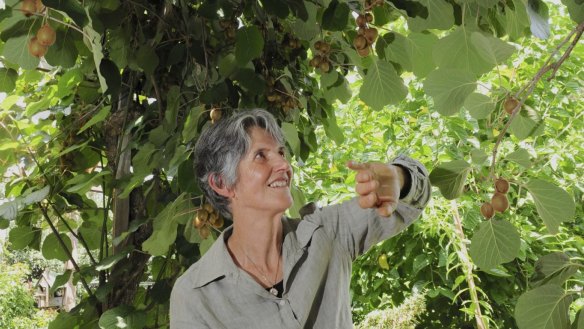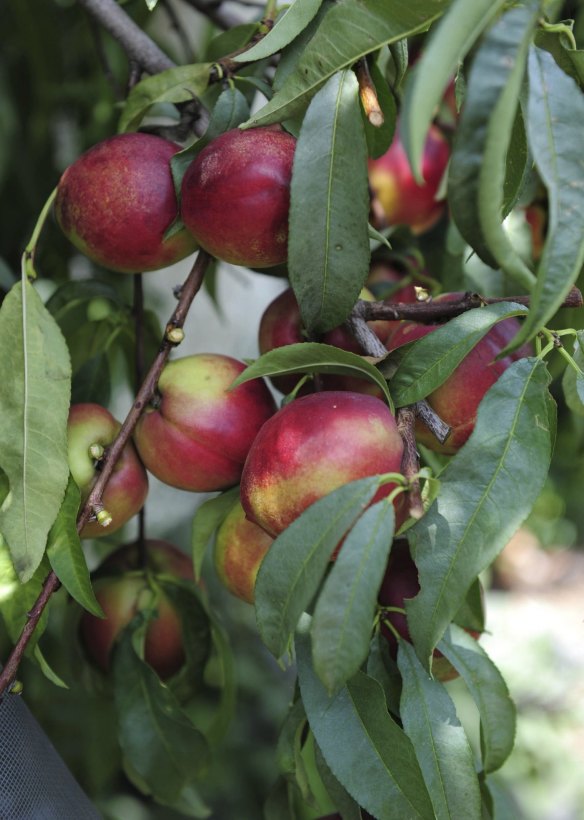Canberra Kitchen Garden: Corine Cordes' fruit garden in Downer

Corine Cordes has been doing yoga for decades and now attends regular classes with Sarah Burns. She has also been learning tai chi for 10 years and believes both keep her supple for gardening. Corine lives in Downer on a block first developed in 1963 with records that show it was 31 perches in size. The north-facing aspect, a productive apricot tree and a muscatel grape vine tempted her to buy the house 21 years ago. The garden has developed slowly as more and more lawn has been converted into beds for growing fruit and vegetables.
There is a surprise around every corner and I have never seen a more densely planted garden of edibles. Our visit on a very hot January day benefited from vines growing on trellises. Magnificent heavily bearing kiwifruit vines provided shade near the house above redcurrant bushes covered with fruit like tiny glass baubles. Corine eats them straight from the garden and more plants have come up willy nilly as the birds like them.
Corine was born in Holland but came to Australia as a three-year-old. She was raised in Long Jetty where a particular delight was climbing in a mulberry tree so she is happy that a four-year-old mulberry in Downer has fruited with more generous watering. There are waltham and maroo table grape vines, roaring lion gooseberries, an autumn crop of raspberries, a two-way royal rainier and grace star cherry tree, espaliered beurre bosc and Williams Bon Chretien pear trees, Santa Rosa and greengage plums, a three-way nectarine with goldmine, fantasia and independence grafts and two peach trees, an elberta and multi-graft red haven, elberta and anzac. Last winter she found room for a dwarf Gravenstein apple and a dwarf lapin cherry tree from Woodbridge Nursery in Tasmania,

Corine's partner, Michael Flynn, loves sitting among the bounty. He is responsible for emptying the kitchen compost bucket into plastic garden compost bins that are placed under the fruit trees among comfrey plants. Because the bins are open-bottomed, encouraging worm activity, they are moved to build up soil fertility in different areas of the garden. Michael's son, Chris, has called this The Garden of Happiness. Star jasmine frames windows and its fragrant flowers bring the bees as do the flowers on a eureka lemon tree which is fed with citrus pellets, potash and Organic Advance Plus from Dickson Garden Centre. There is a hedge of fruitful feijoas and a lemon verbena bush lifts its fragrance to the air as you brush past it. Parsnips are fertilised by the bees and are allowed to go to seed.
Currawongs and Corine love the astringent fruit of the persimmon tree under which eggplants, yarrow and golden marjoram are growing. There are flowers too, for beauty, including dahlias and cosmos. An unusual plant, purchased from EPIC markets as red cabbage, seems to be ruby red brussel sprouts, which adds to the allure and fun of gardening.
Early inspirations for all this bounty have been the concept of permaculture through Bill Mollison, biodynamic growing, Peter Cundall on ABC gardening, Canberra Organic Growers Society and learning from vegetable-growing friends and neighbours. For information about soil fertility she finds Masanobu Fukuoka's The Natural Way of Farming and Tim Marshall's book Organic Gardening useful. Corine includes a green manure crop in the soil cycle and practises four-bed rotation of the solanaceae family, legumes, brassicas and onions/carrots/beetroots using cucurbits and lettuce as "floaters". Visiting the Canberra garden of Richard Stirzaker indicated how much food could be grown in a backyard.
In her final years of teaching English as a second language in Canberra, Corine says she was lucky to be involved in a gardening project. An outdoor classroom provided a rich environment for oral communication among students from diverse language and cultural backgrounds. Summer salads and baked vegetable dishes are seasonal favourites in which homegrown chantenay carrots, potatoes, garlic, red and green lettuces, mizuna, young dandelion leaves, beetroot, five varieties of tomatoes, silverbeet, butternut pumpkin, lebanese and telephone cucumbers, pak choy, asparagus, kale and corn are harvested and used immediately. Manzanita olives are brined, bottled and shared with friends.
For dessert there are figs, boysenberries, youngberries, goji berries, rhubarb, grapes and apricots.
Apricot crumble
Stew a quantity of apricots to suit the number of people at the table. Ramekins work well as the dishes. Your preferred sweetener can be added – stevia powder (one measuring scoop in stevia container per ramekin), honey or sugar. Top the apricots lightly with crumble mix and bake for about 30-40 minutes at 180C or until topping starts to brown.
Crumble topping:
150g oats
100g ground almonds
50g shredded coconut
50g flour
1 tbsp butter
3 tbsp honey
a light sprinkling of ground cinnamon
(Corine adds coconut flakes)
Combine the ingredients, working the honey and butter well through the mix. Any remaining crumble keeps well in the fridge for a few days.